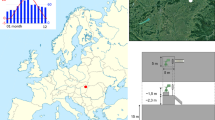Abstract
The methods using plants for biomonitoring of air and soil quality are simple, cheap, and fast and can supplement the classical physicochemical methods. In this study, biological pollen characterization of some collected legume species from an aluminum smelter area in Iran (IRALCO) was carried out to determine the actual value of pollen as a bioindicator of the effects of soil and atmospheric pollution. Young buds and flowers of six legumes (Cercis siliquastrum L., Medicago sativa L., Robinia pseudoacacia L., Melilotus officinalis (L.) lam, Trifolium repens L., and Sophora alopecuroides L.) in polluted and control plants were removed and compared. Studies of light and electron microscopic preparation showed some abnormalities during pollen development in affect of fluoride pollution. The viability of pollen grains estimated by staining with acetocarmine shows sharp differences in smearing advanced pollen grains from abnormal ones. Except M. officinalis, the pollen grains of C. siliquastrum, M. sativa, R. pseudoacacia, T. repens, and S. alopecuroides in polluted areas showed light, partial, or no staining with acetocarmine, whereas almost all of the control ones clearly stained. Observation of the pollen grains by light microscopy and scanning electron microscopy showed the significant effect of fluoride on shapes and sizes of pollen grains. The stimulation and inhibition of these pollen characteristics depend on the pollen species as well as on the pollutant and its concentration. Therefore, pollen grains provide essential information on biological impact of pollutants and they are good candidates for biomonitoring the atmospheric and edaphic pollutions.


Similar content being viewed by others
References
Arndt U, Flores F, Weinstein L (1995) Fluoride effects on plants. Diagnosis of injury in the vegetation of Brazil. Editora UFRGS, Porto Alerge, p. 155
Asghari J (2000) Estimation of pollen viability of metsulfuron treated dyers woad (Isatis tinctoria) for herbicide efficacy evaluation. J Agr Sci Tech 2:85–93
Bellani LM, Paoletti E, Cenni E (1988) Air pollution effects on pollen germination of forest species. In: Cresti M, Gori P, Pacini E (eds) Sexual reproduction in higher plants. Springer-Verlag, Berlin, pp 265–270
Comtois P, Schemenauer RS (1991) Tree pollen viability in areas subject to high pollutant deposition. Aerobiologia 7:144–151
Fornasiero RB (2001) Phytotoxic effects of fluorides. Plant Sci 161:979–985
Gottardini E, Cristofolini F, Paoletti E, Lazzeri P, Pepponi G (2004) Pollen viability for air pollution bio-monitoring. J Atmos Chem 49:149–159
Iannotti O, Mincigrucci G, Bricchi E, Frenguelli G (2000) Pollen viability as a bio-indicator of air quality. Aerobiologia 16:361–365
IRMO (Iran Meterological Organization). (2000). Meterological Year Book. Ministry of Road and Transportation.
Majd A, Chehregani A, Moin M, Gholami M, Kohno S, Nabe T, Shariatzade MA (2004) The effects of air pollution on structures, proteins and allergenicity of pollen grains. Aerobiologia 20(2):111–118
Malayeri BE, Chehregani A, Yousefi N, Lorestani B (2007) Identification of the hyper accumulator plants in copper and iron mine in Iran. Pak J Biol Sci 11(3):490–492
Noori M, Malayeri BE, Jafari M (2009) Determination of fluoride and its effects on flavonoids in some legumes. Toxicol Environ Chem 91(3):409–418
Treshow M, Pack MR (1970) Fluoride. In: Jacobson,J.S. and Hill, A.C., Editors, 1970. Recognition of air pollution injury to vegetation.
Weinstein LH (1977) Fluoride and plantlife. J Occup Med 19:49–78
Weinstein LH, Davison AW (2003) Native plant species suitable as bioindicators and biomonitors for airborne fluoride. Environ Pollut 125:3–11
Wolters JHB, Martens MJM (1987) Effects of air pollutants on pollen. Bot Rev 53:372–414
Yousefi N, Chehregani A, Malayeri BE, Lorestani B, Cheraghi M (2011) Investigating the effect of heavy metals on developmental stages of anther and pollen in Chenopodium botrys L. (Chenopodiaceae). Biol Trace Elem Res 140:368–376
Author information
Authors and Affiliations
Corresponding author
Rights and permissions
About this article
Cite this article
Malayeri, B.E., Noori, M. & Jafari, M. Using the Pollen Viability and Morphology for Fluoride Pollution Biomonitoring. Biol Trace Elem Res 147, 315–319 (2012). https://doi.org/10.1007/s12011-011-9290-8
Received:
Accepted:
Published:
Issue Date:
DOI: https://doi.org/10.1007/s12011-011-9290-8




